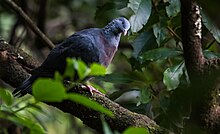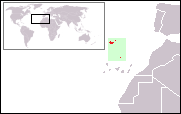
Back حمامة تروكاز Arabic حمام تروكاز ARZ Columba trocaz Azerbaijani Мадейрански гълъб Bulgarian Colom de Madeira Catalan Columba trocaz CEB Colomen Trocaz Welsh Silberhalstaube German Madejra kolombo Esperanto Columba trocaz Spanish
| Trocaz pigeon | |
|---|---|

| |
| Scientific classification | |
| Domain: | Eukaryota |
| Kingdom: | Animalia |
| Phylum: | Chordata |
| Class: | Aves |
| Order: | Columbiformes |
| Family: | Columbidae |
| Genus: | Columba |
| Species: | C. trocaz
|
| Binomial name | |
| Columba trocaz Heineken, 1829
| |

| |
| Location map | |
| Synonyms | |
| |
The trocaz pigeon, Madeira laurel pigeon or long-toed pigeon (Columba trocaz) is a pigeon which is endemic to the island of Madeira, Portugal. It is a mainly grey bird with a pinkish breast; its silvery neck patch and lack of white wing markings distinguish it from its close relative and probable ancestor, the common wood pigeon. Its call is a characteristic six-note cooing, weaker and lower-pitched than that of the wood pigeon. Despite its bulky, long-tailed appearance, this pigeon has a fast, direct flight.
A scarce resident breeder in laurisilva forests, the trocaz pigeon lays one white egg in a flimsy twig nest. Its numbers fell sharply after human colonisation of the Madeira archipelago, and it vanished altogether from Porto Santo Island. The major cause of its population decline was habitat loss from forest clearance, but hunting and nest predation by introduced rats were also contributory factors. Protection of the laurel forests and a ban on hunting have enabled numbers to increase, so that the species is no longer endangered.
- ^ BirdLife International (2017). "Columba trocaz". IUCN Red List of Threatened Species. 2017: e.T22690112A118618501. doi:10.2305/IUCN.UK.2017-3.RLTS.T22690112A118618501.en. Retrieved 19 November 2021.
- ^ Voisin, C.; Voisin, J.-F.; Jouanin, C.; Bour, R. (2005). "Liste des types d'oiseaux des collections du Muséum national d'Histoire naturelle de Paris, 14: Pigeons (Columbidae), deuxième partie" (PDF). Zoosystema (in French). 27 (4): 839–866. Archived from the original (PDF) on 2011-06-12.
- ^ Shelley, G. E. (1883). "On the Columbidae of the Ethiopian Region". Ibis. 25 (3): 258–331. doi:10.1111/j.1474-919X.1883.tb07172.x.
- ^ Godman, F du Cane (1872). "Notes on the Resident and Migratory Birds of Madeira and the Canaries". Ibis. 14 (3): 209–224. doi:10.1111/j.1474-919X.1872.tb08403.x.
